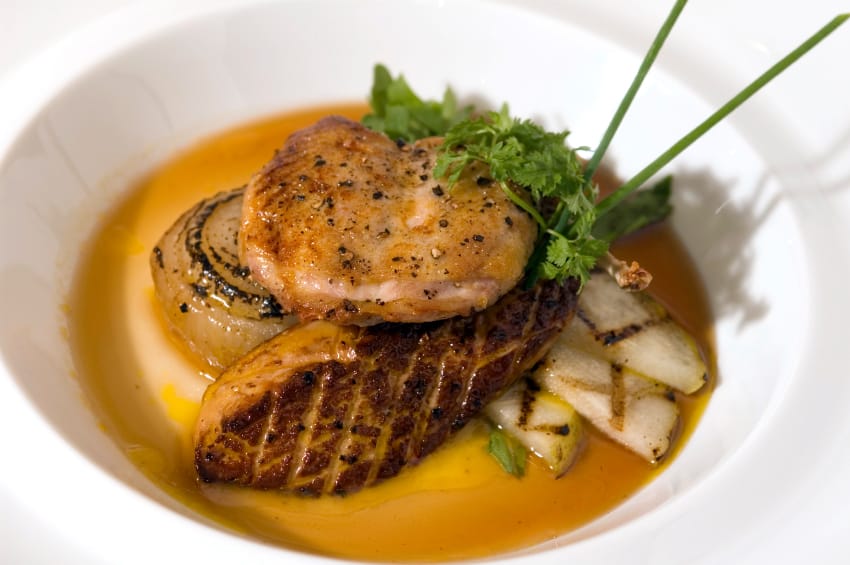Grilled foie gras and vegetables in a savory broth.
I remember watching Dances with Wolves during my childhood—particularly the scene where Lieutenant Dunbar participates in a hunt for “Tatanka,” or wild bison. After the kill, one of the Lakota warriors cuts open the fallen bison, pulls out its warm heart, and offers it to the dumbfounded lieutenant. What would you do if someone handed you the fresh, warm heart of an animal? I once knew.
When I was a child, my mother would prepare various soups and dishes with kidneys, hearts, liver, tripe, bone marrow, and other organs. In this way, we ate much like the Lakota and other native cultures. However, as I grew to be an impressionable teenager, I succumbed to the advertisements of mainstream media. I began seeking out processed and fast-foods and avoiding the organ meats and tissues my mother cooked with.
Most of us would cringe at the sight of a raw, steamy organ, ripped fresh from an animal that was once alive. However, many native tribes and primitive cultures intuitively know that organ meats are the most nutrient-dense foods on the planet.
Heart tissue, for example, is a rich source of coenzyme Q10. It also supplies our body’s cells with the nutrients required for adenosine triphosphate production and cellular respiration. After all, more than any other muscle in the body, the heart is the most active. It therefore requires the greatest amount of muscle nutrition.
Nearly all of the 14 primitive societies that Dr. Weston A. Price studied—and found in perfect health—consumed organ meats. The Gaelic-speaking people prized all fish organs, while the people of the Outer Hebrides consumed liver. Alaskan Eskimos ate the organs of large marine animals, including the skin of one particular whale found to be rich in vitamin C. Other European village societies were fond of cod liver, and the north Canadian Indians consumed adrenal glands as their main source of the vitamin C complex. Modern nutritional science has since confirmed that the adrenal glands are the richest source of vitamin C to be found in all animal or plant tissues.
Many of Dr. Royal Lee’s formulas contain organ tissue extracts, including his first multiple food formula, Catalyn. Due to the domestication of the human species, we’ve long forgotten our healthier ancestral ways. Many of my clients are nutritionally starved of the very nutrients that can only be found in food. When confronted with a grimace of awkward disgust at the suggestion that they add organ tissue to their diet, I often remind my clients, “Just because you don’t want to eat it doesn’t mean your body doesn’t need it.”
Being of (half) Chinese descent, I grew up learning what most Chinese people and practitioners of traditional Chinese medicine know—that organ meats are nutritional building blocks that not only optimize the function of our own organs, but also bolster their repair. There’s a common expression among the Chinese, “???????,” or “Eat that organ which you wish to fortify.” If you utter these words among Chinese speakers, they’ll nod their heads in agreement. Ironically, newer generations of Chinese have fallen victim to the domestication of modern society—and few, if any, actually consume organ meats.
Dr. Royal Lee was quite aware that our modern day palates were highly impressionable to consumer-focused advertisements. He also understood how the consumption of organ meats could replenish years of missing nutrition from a diet of devitalized and processed foods. Many of his whole food concentrate formulas include such animal tissues for this very reason.
You can restore or maintain your health with a holistic healthcare practitioner who dispenses Dr. Royal Lee’s whole food concentrates. At the same time, venture out and try some goose liver pâté, duck liver foie gras, thymus, and pancreas sweetbreads—or even a bison’s steaming, raw heart. Read more about how to prepare and serve organ meats here. Also check out the recipes of 5-star chef Chris Cosentino, a huge fan of creating offal delicious entrees.
Photo from iStock/otokimus
Related Topics
holistic health | whole food nutrition
 Get self-health education, nutrition resources, and a FREE copy of A Terrible Ten: Health Foods That Ain't ebook.
Get self-health education, nutrition resources, and a FREE copy of A Terrible Ten: Health Foods That Ain't ebook.

Pingback: Mediterranean-Style Chicken Liverswith Olives and Tomatoes | Selene River Press
What an offal pun.